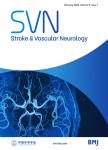Shenzhen stroke emergency map improves access to rt-PA for patients with acute ischaemic stroke
作者机构:Department of NeurologyShenzhen University First Affiliated HospitalShenzhen Second People’s HospitalShenzhenChina Department of NeurologyShenyang First People’s HospitalShenyang Medical CollegeShenyangChina
出 版 物:《Stroke & Vascular Neurology》 (卒中与血管神经病学(英文))
年 卷 期:2019年第4卷第3期
页 面:115-122页
核心收录:
基 金:This work was supported by the Science and Technology Innovation programme of Shenzhen Science and Technology Commission(grant number:JCYJ20151030151431727) Shenzhen Health and Population Family Planning Commission(grant number:SZLY2017012) Shenzhen Development and Reform Commission’s Stroke Screening and Prevention Public Service Platform improving programme.
摘 要:Prehospital delay is one of the major causes of low rate of intravenous recombinant tissue plasminogen activator(rt-PA)thrombolysis for acute ischaemic stroke in China.Regional emergency systems have been proven a successful approach to improve access to thrombolysis.Shenzhen is a high population density city with great geographical disparity of healthcare resources,leading to limited access to rt-PA thrombolysis for most patients with acute ischaemic stroke.To improve rapid access to rt-PA thrombolysis in Shenzhen,a Shenzhen stroke emergency map was implemented by Shenzhen healthcare administrations.This map comprised certification of qualified local hospitals,identification of patients with stroke,acute stroke transport protocol and maintenance of the map.We conducted a retrospective observational study to compare consecutive patients with acute stroke arriving at qualified local hospitals before and after implementation of the Shenzhen stroke emergency map.After implementation of the map,the rate of patients receiving rt-PA thrombolysis increased from 8.3%to 9.7%(p=0.003),and the rate of patients treated with endovascular thrombectomy increased from 0.9%to 1.6%(p0.001).Sixteen of 20 hospitals have an increase in the number of patients with stroke treated with rt-PA thrombolysis.The median time between receipt of the call and arrival on the scene reduced significantly(17.0 min vs 9.0 min,p0.001).In Shenzhen Second People s Hospital,the median onset-to-needle time and door-to-needle time were reduced(175.5 min vs 149.5 min,p=0.039;71.5 min vs 51.5 min,p0.001).No statistically significant differences were found in the proportion of rt-PA-treated patients within various geographical distances.Currently,there are more than 40 cities in China implementing a stroke emergency map.The Shenzhen stroke emergency map improves access to rt-PA thrombolysis for acute ischaemic stroke,and the novel model has been expanded to multiple areas in China.Future efforts should be conducted to optimise the stroke emergency map.



